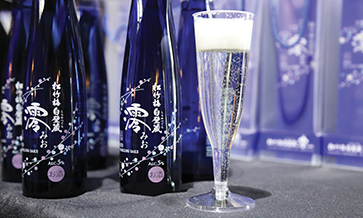Sake is an alcoholic beverage which is brewed from water, rice and koji (malted rice). Koji is made by planting microbes called kojikin in the rice. Therefore, the taste and flavour of the resulting Sake relies heavily on the quality of water and rice.
In each region of Japan, there are places where crystal-clear springs exist in the mountains and under the ground. Sake is made from this high-quality water from such regions.
Nada in Hyogo Prefecture and Fushimi in Kyoto Prefecture are examples of places where good quality spring water is used to brew Sake since olden times. The minerals in these springs act as important nutrients for koji.
In Japan, high-quality rice is produced in Hokkaido in the north and Okinawa in the south. This rice, called Sakamai, is used to make Sake. ‘Yamada Nishiki’ in Hyogo Prefecture is a famous brand that produces name for both Sakamai and Sake. Niigata Prefecture, where a lot of famous Sake is produced, is also a place where a lot of high quality Sakamai is produced.
Good taste
Rice contains a lot of protein and fat that affects its umami (good taste) in the margins, and a lot of starch that determines the pure taste of rice in the centre. The sweetness of Sake depends on the amount of glucose produced from starch, and the amount of acid which affects the acidity, as is the case with wine, but umami and protein also play an important role with Sake.
However, in order to make Sake with an excellent taste and aroma, the surplus protein and fat in the margins must be scraped off. The resulting sharpness affects the taste and aroma of Sake.
The process of brewing Sake is slightly more complicated than other alcoholic beverages. Rice that has been milled and steamed with water is used in the following three processes.
First, koji is to be made. Second, the moto is made by mixing steamed rice, koji, yeast and water and ferment in order to cultivate a large amount of yeast. Third, the moto, steamed rice, koji, yeast and water is mixed and fermented to make moromi – the original Sake. The process of making Sake is completed by proving and filtering moromi.
Sake varieties
The main types of Sake include ordinary Sake (Futsu-shu), Ginjo-shu, Junmai-shu and Honjozo-shu. The Futsu-shu is any Sake other than Ginjo-shu, Junmai-shu and Honjozo-shu.
Ginjo-shu is a kind of Sake made from rice grains where more than 40% of the outer layer has been scraped off. Among these, Sake which is made from rice grains that have been scraped off more than half is called Daiginjo-shu.
Jummai-shu is Sake brewed using only water, rice and koji. Honjozo-shu is a Sake made by rice where more than 30% is scraped off, and adding alcohol brewed separately from starch and sugary components to further improve the fragrance and colour and to enhance its preservation.
In addition, there are Namazake that is not heated to enhance its shelf-life, and Happoshu; Sake into which carbon dioxide has been blown.
Food pairing
Sake goes quite well with most dishes and is said to match sashimi and egg-based dishes. In order to seal the marriage between Japanese Sake and food, sake is divided into four types: Kunshu, Soshu, Junshu and Jukushu.
Kunshu is Japanese Sake which is characterised by a fruity taste and lovely fragrance, such as Ginjo-shu and Daiginjo-shu, and is said to go very well with sashimi and mildly flavoured dishes.
Soshu is characterised by its refreshing and sharp taste, such as Namazake and Honjozo-shu, and is said to match dishes with a slight sweetish taste.
Junshu is a type of Sake that lets us taste the umami of rice, such as Jummai-shu, and is said to match strongly flavoured meat dishes and food that uses cheese, butter and cream.
Jukushu is aged Sake that has a deep aroma and taste. Because it has a strong taste, it is harmonised with deep-fried food and richly flavoured snacks.
Because Sake is brewed through fermenting rice, it may also be suitable for fermented foods such as dosa, and South Indian cuisine with many fish dishes.
Hot or cold?
A major feature of Sake is that it can be enjoyed at various temperatures; from cold to hot, depending on the taste and aroma of each variety of Sake. It is said to lose its bitterness and aroma as the temperature rises, which increases its sweetness and enriches its flavour.
Therefore, Sake which has a sharp taste or aroma and the Namazake are recommended to drink chilled. On the other hand, Sake with a strong taste is recommended to be imbibed heated.
October is the month when new cereals come to fruition, and when, in the old days, farm work decreased, young people from rural areas participated in Sake brewing.
For these reasons, the Sake and Shochu Makers’ Association established October 1st as ‘Sake Day’ in 1978. Today, it is also called ‘International Sake Day’.











